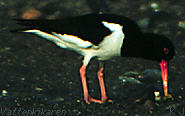The high mortality rate amongst
cliff organisms during their different phases of life results in an
over-production of millions of "embryoes" for every generation
so that the populations can continue to exist and not became extinct.
This high rate of reproduction plays an important roll in the versatility
and variation of cliff fauna. Periods of low embryo mortality result
in the establishment of large populations over large areas. This can
be the result of e.g. increased food resources for a specific species
of larva which enables them to grow quickly and transform to their
bottom- living stage before they are eaten by other creatures. If
they are a long-living species, they can dominate a beach for a period
of several years.
To convince yourself that the survival and development
of embryoes is of great importance, you can try our calculation
exmple.
Where larve are transported, is also of importance.
Independent of how many survive the plankton stage, large variations
exist in the number of larvae that arrive at in the different areas.
|
Different areas of water contain
varying quantities of larvae and it is often circumstance that decides
if currents
and waves carry a swarm of small larvae to a given place. Only differences
in how many larvae arrive to a given place can explain why a certain
species can dominate in a certain area. We know very little about
the significance of spore distribution, egg fertilization and larvae
to be able to determine how common a species would be on different
beaches. With the aid of scientific
experiments we would be able to determine how important embryo
distribution is, compared to other factors like the physical and chemical
conditions on the beach, competition and predation. 
The oystercatcher eats Marine organisms on most types of beaches.
|


